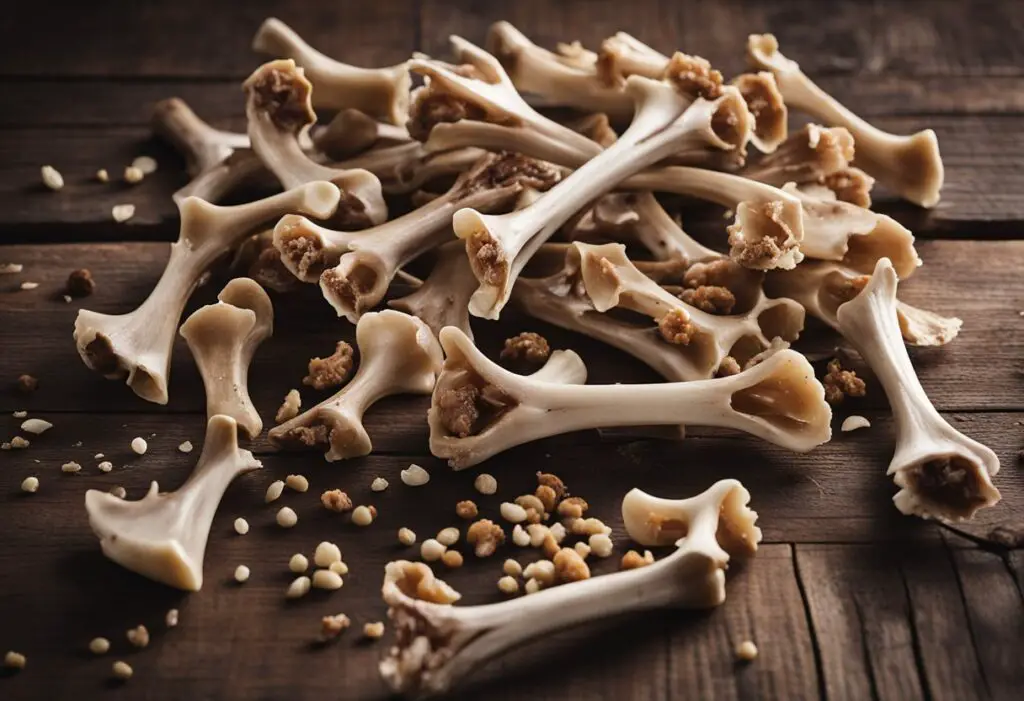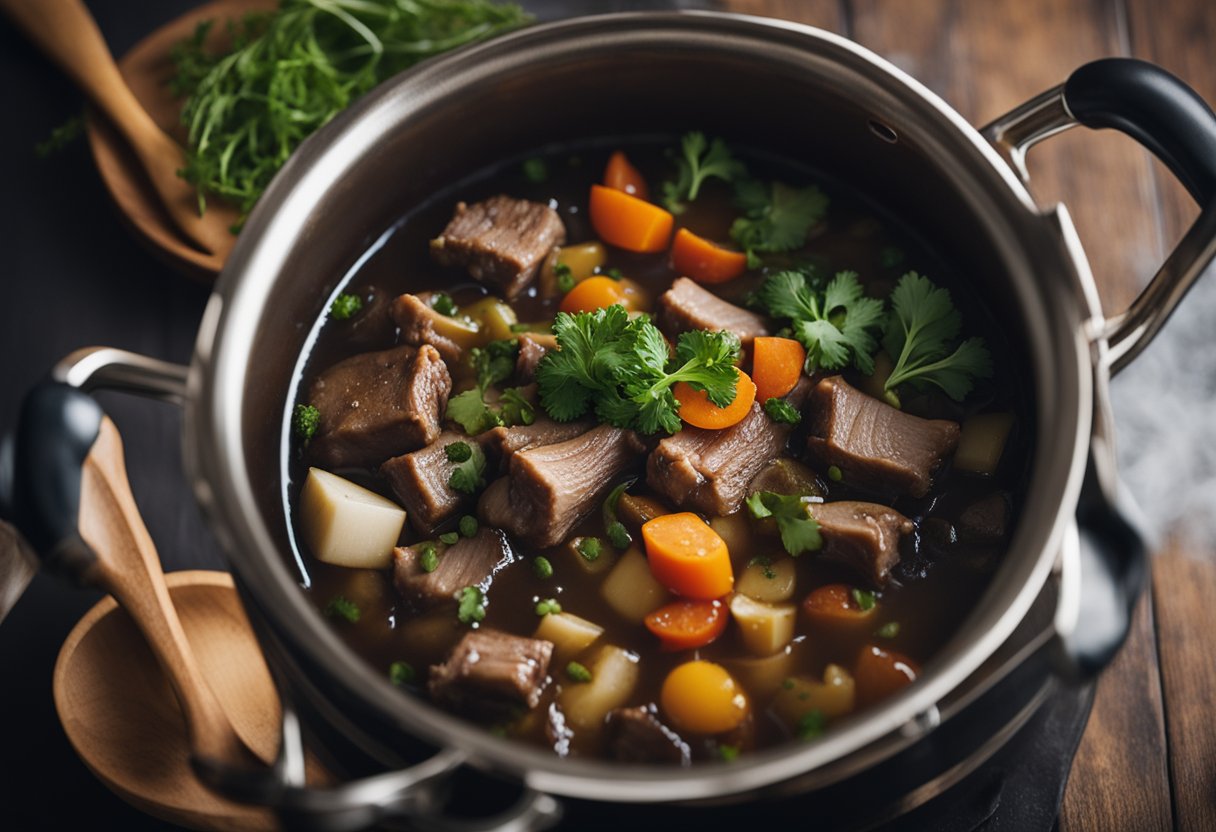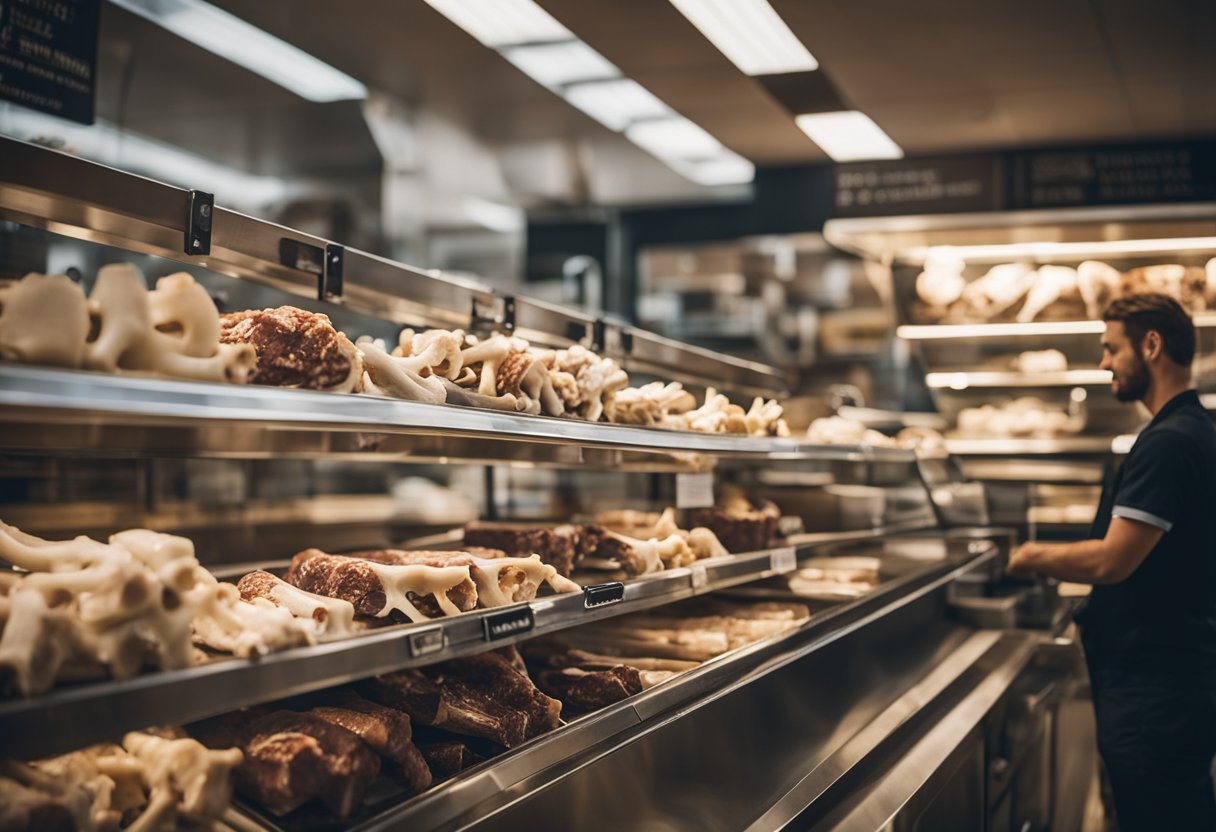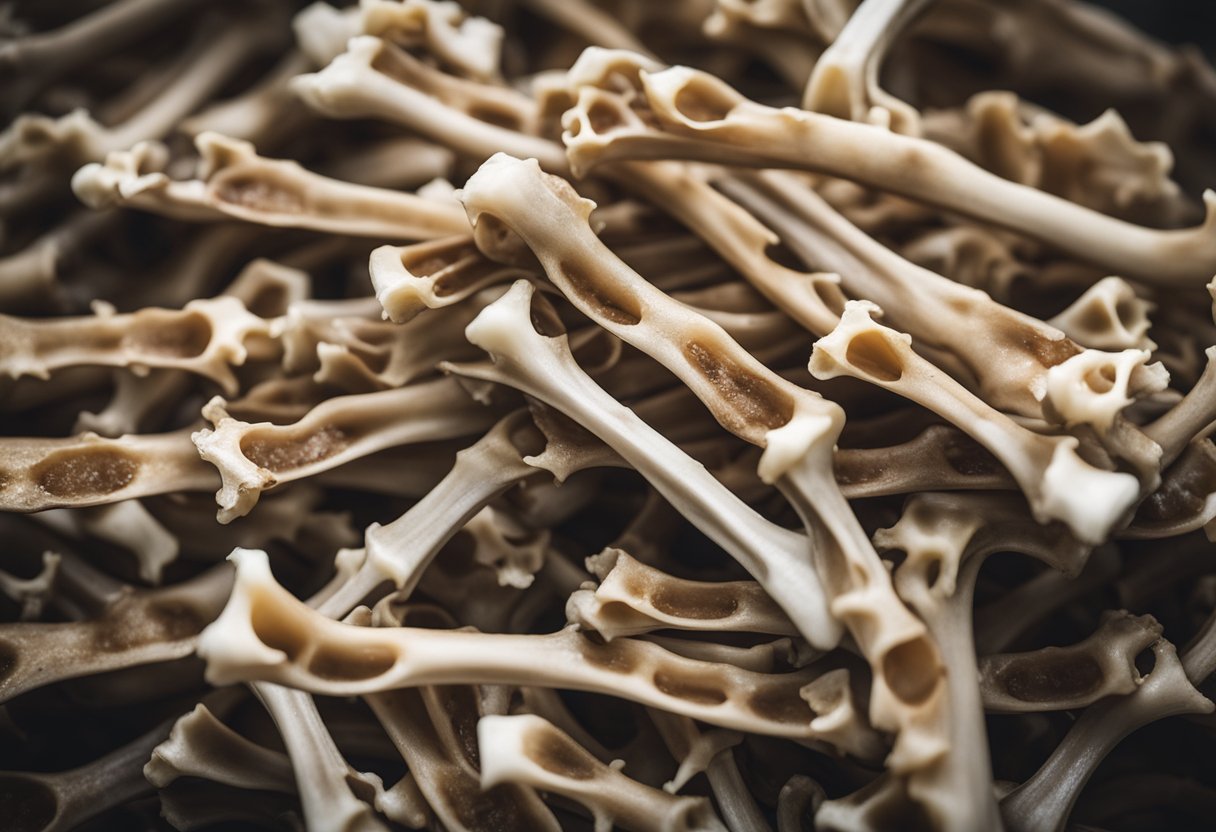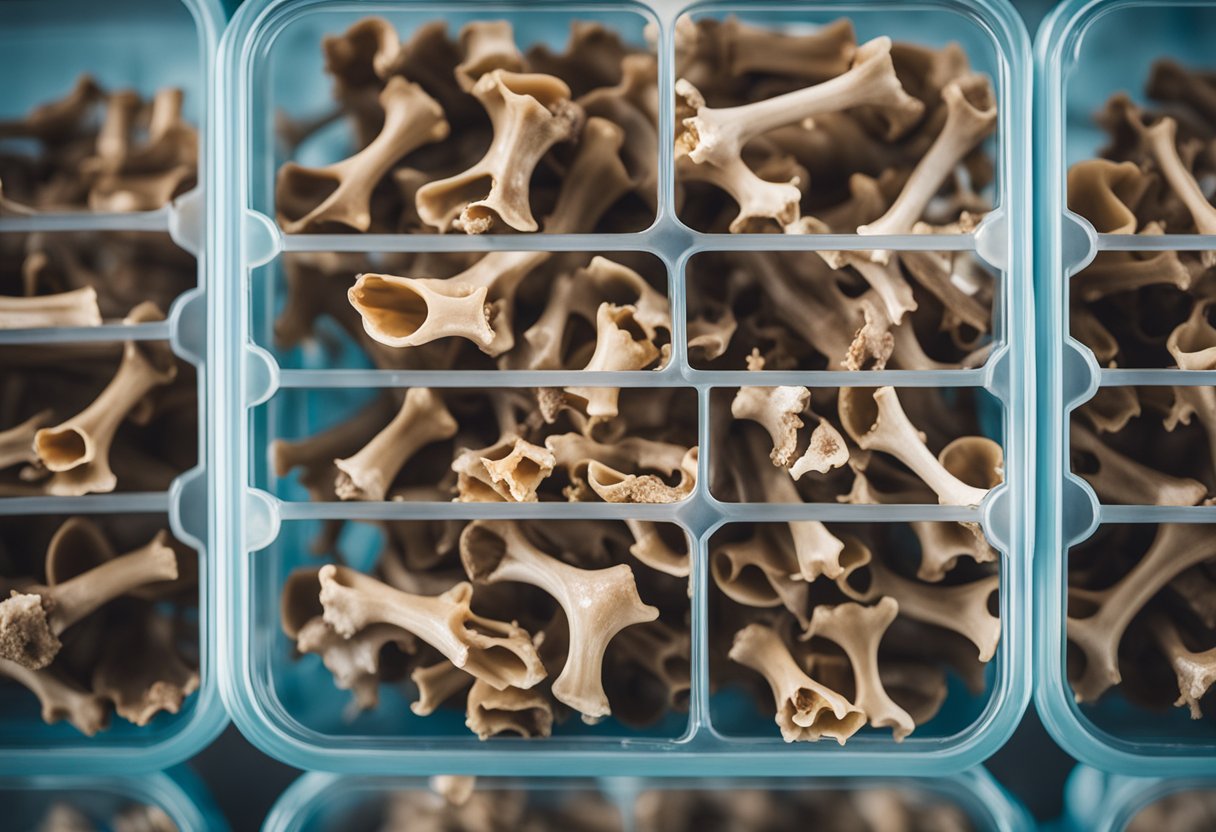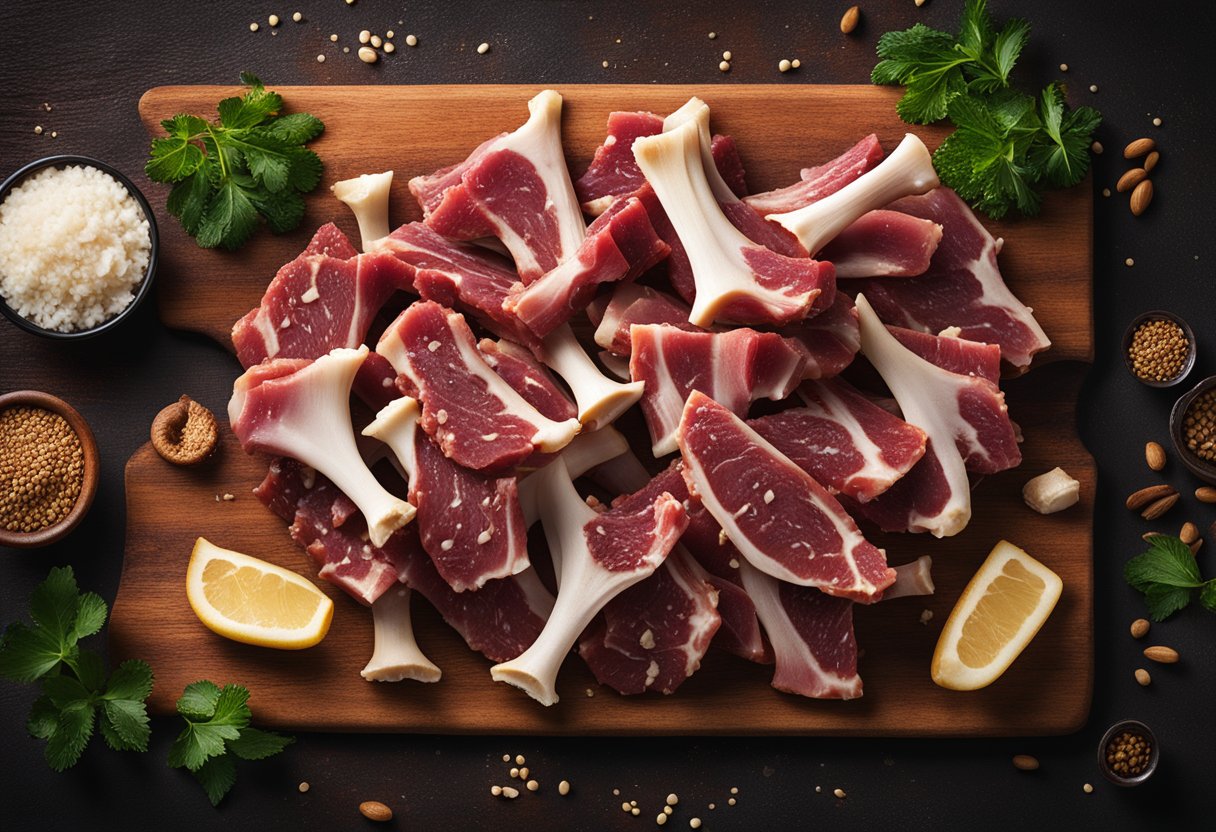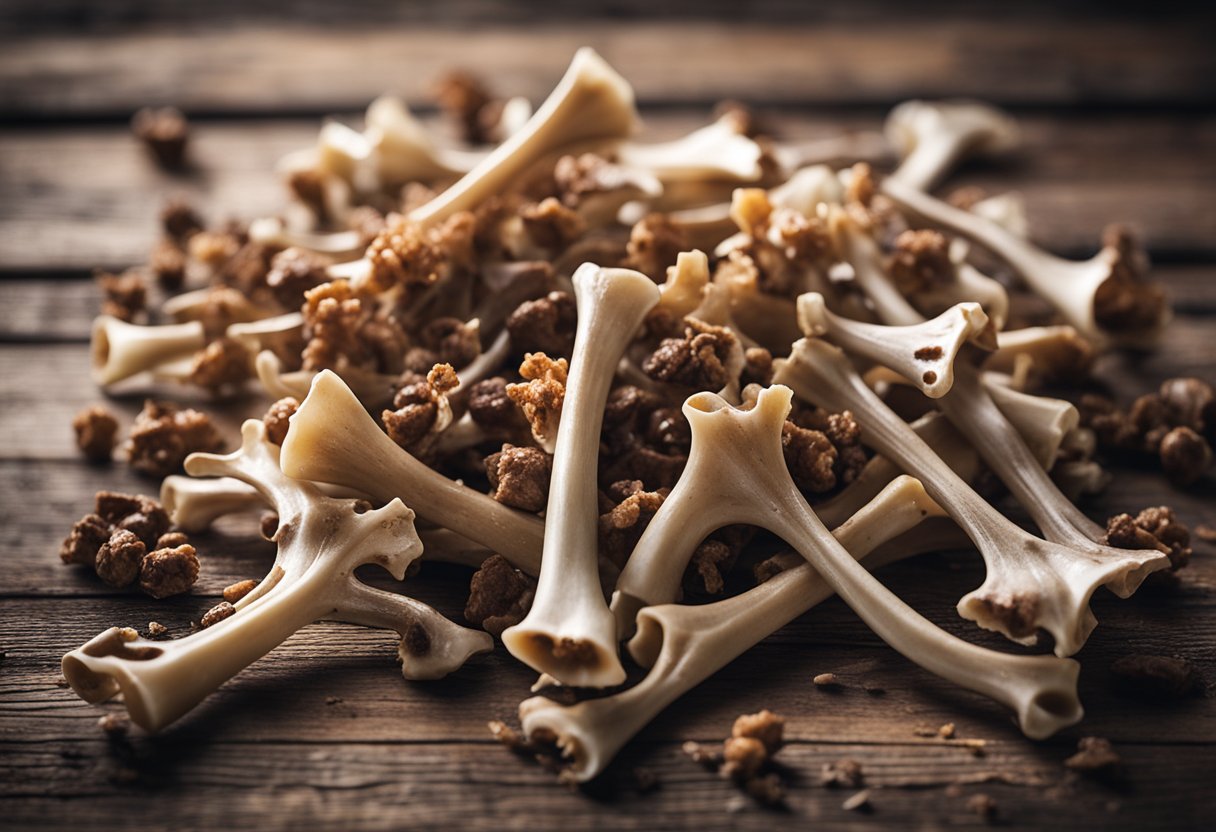If you’re a meat lover, you’re probably familiar with the concept of using beef bones to add flavor and nutrition to your meals. Beef bones are a versatile ingredient that can be used in a variety of dishes, from soups and stews to bone broth and pet food. Not only do they add a rich, savory flavor to your meals, but they’re also packed with nutrients like collagen, calcium, and magnesium.
One of the main benefits of using beef bones in your cooking is that they add a depth of flavor that you just can’t get from other ingredients. When you simmer bones in water for an extended period of time, the collagen and other nutrients are released into the broth, creating a rich, savory flavor that’s perfect for soups, stews, and sauces. Additionally, beef bones are a great source of calcium, which is essential for strong bones and teeth, and magnesium, which is important for muscle and nerve function.
Whether you’re looking to make a hearty beef stew or a nutritious bone broth, beef bones are an excellent ingredient to have on hand. With their rich, savory flavor and impressive nutritional profile, they’re a versatile ingredient that can be used in a variety of dishes. So why not give them a try and see how they can enhance your favorite recipes?
Beef Bones Overview
Beef bones are an essential ingredient in many dishes, particularly in soups and stews. They are known for their rich flavor and nutritional value. In this section, you will learn about the different types of beef bones, their nutritional value, and how to use them in your cooking.
Types of Beef Bones
There are several types of beef bones, each with its unique flavor and nutritional benefits. Some of the most common types of beef bones include:
- Knuckle Bones: These are the large, round bones that are located near the joints of the cow. They contain a lot of cartilage and connective tissue, which makes them perfect for making beef broth and stock.
- Marrow Bones: These are the long, tubular bones that contain marrow, which is a rich source of nutrients and flavor. Marrow bones are often roasted and served as a delicacy.
- Oxtail: This is the tail of the cow, which contains a lot of meat and bones. Oxtail is often used in stews and soups to add flavor and texture.
- Short Ribs: These are the ribs that are cut into short pieces. They contain a lot of meat and bones, which makes them perfect for slow cooking.
Nutritional Value
Beef bones are a rich source of nutrients, including:
- Calcium: Beef bones are an excellent source of calcium, which is essential for strong bones and teeth.
- Collagen: Beef bones contain collagen, which is a protein that helps to support healthy skin, hair, and nails.
- Gelatin: Beef bones contain gelatin, which is a protein that helps to support healthy joints and digestion.
Culinary Uses
Beef bones are a versatile ingredient that can be used in many different dishes. Here are some of the most popular culinary uses for beef bones:
- Beef Broth: Beef bones are often used to make beef broth, which is a flavorful and nutritious base for soups and stews.
- Roasted Marrow Bones: Marrow bones can be roasted and served as a delicacy. Simply season the bones with salt and pepper and roast them in the oven until the marrow is soft and creamy.
- Oxtail Stew: Oxtail is often used in stews and soups to add flavor and texture. Try making a hearty oxtail stew with vegetables and herbs for a delicious and nutritious meal.
- Beef Pho: Beef bones are an essential ingredient in Vietnamese beef pho, which is a flavorful and aromatic noodle soup.
Preparation Techniques
When it comes to preparing beef bones, there are a few important techniques to keep in mind. Here are some tips to help you get the most out of your bones:
Selecting Quality Bones
The first step in preparing beef bones is to select high-quality bones. Look for bones that are fresh and have a good amount of meat and fat on them. The meat and fat will add flavor and richness to any dishes you make with the bones. You can purchase bones from your local butcher or meat market, or you can order them online.
Cleaning and Storage
Once you have selected your bones, it is important to clean them thoroughly before using them. Rinse the bones under cold running water to remove any dirt or debris. You can also soak the bones in cold water for a few hours to help remove any impurities. After cleaning, pat the bones dry with a paper towel.
It is also important to store your bones properly. Place them in a plastic bag and store them in the refrigerator or freezer until you are ready to use them. If you are storing them in the freezer, be sure to label the bag with the date so you can keep track of how long they have been frozen.
Roasting Methods
Roasting beef bones is a great way to bring out their flavor and prepare them for use in soups, broths, and other dishes. To roast your bones, preheat your oven to 450°F. Place the bones on a baking sheet and roast for 15 minutes. This will help to brown the bones and bring out their natural flavors.
After roasting, you can use the bones to make a delicious beef broth or stock. Simply place the bones in a large pot with water and any other ingredients you would like to add, such as vegetables or herbs. Bring the mixture to a boil, then reduce the heat and let it simmer for several hours. The longer you simmer the broth, the more flavorful it will be.
By following these preparation techniques, you can ensure that your beef bones are of the highest quality and will add rich flavor to any dish you make with them.
Cooking with Beef Bones
If you’re looking for a way to add depth of flavor to your dishes, beef bones are a great ingredient to have on hand. Not only do they add flavor, but they’re also a great source of collagen, which is good for your skin, hair, and nails.
Stocks and Broths
One of the most common ways to cook with beef bones is to use them to make stocks and broths. These can be used as a base for soups, stews, and sauces, or they can be enjoyed on their own as a warming and nourishing drink.
To make a beef bone broth, simply simmer the bones in water for several hours, along with any vegetables and herbs you like. Strain the broth and discard the solids, then season to taste with salt and pepper. You can also add a splash of vinegar to help extract more nutrients from the bones.
Bone Marrow Dishes
Another way to cook with beef bones is to use the marrow inside them. Bone marrow is a rich, fatty substance that adds a luxurious texture and flavor to dishes.
To extract the marrow from beef bones, roast them in the oven until the marrow is soft and melty. Then, scoop out the marrow and use it to make sauces, spread it on toast, or add it to soups and stews for extra richness.
Slow-Cooked Meals
Finally, beef bones can be used to add flavor and nutrition to slow-cooked meals like pot roasts and braises. Simply add the bones to the pot along with the other ingredients and let them simmer for hours, infusing the dish with their rich flavor and nutrients.
Overall, beef bones are a versatile and nutritious ingredient that can add depth of flavor and nourishment to a wide range of dishes. Whether you’re making a broth, using the marrow, or slow-cooking a meal, beef bones are a great way to elevate your cooking and support your health.
Health Benefits
If you’re looking for a nutrient-dense food that can help support your overall health, beef bones are a great option to consider. Here are some of the key health benefits associated with consuming beef bones:
Bone Broth Benefits
One of the most popular ways to consume beef bones is in the form of bone broth. Bone broth is made by simmering beef bones in water for an extended period of time, typically 24 hours or more. This process helps to extract the nutrients and minerals from the bones, creating a nutrient-dense broth that can be used as a base for soups, stews, and other dishes.
Some of the potential health benefits of bone broth include:
- Improved digestion: The gelatin in bone broth can help to soothe and heal the digestive tract, making it a great option for those with digestive issues.
- Joint health: The collagen in bone broth may help to support joint health and reduce inflammation in the body.
- Skin health: The high levels of collagen in bone broth may also help to improve skin health and reduce the appearance of wrinkles and fine lines.
- Immune support: The amino acids in bone broth may help to support immune function and reduce inflammation in the body.
Mineral Content
In addition to being a great source of protein, beef bones are also packed with essential minerals like calcium, magnesium, and phosphorus. These minerals are important for maintaining strong bones and teeth, as well as supporting overall health and wellbeing.
Collagen and Gelatin
Another key benefit of consuming beef bones is that they are a rich source of collagen and gelatin. These two compounds are important for maintaining healthy skin, hair, and nails, as well as supporting joint health and reducing inflammation in the body.
Overall, beef bones are a nutrient-dense food that can provide a wide range of health benefits. Whether you’re looking to improve your digestion, support joint health, or simply add more nutrient-dense foods to your diet, beef bones are definitely worth considering.
Buying Guide
Sourcing Beef Bones
When it comes to sourcing beef bones, there are a few options available. You can purchase beef bones from your local grocery store, butcher, or online. If you decide to purchase online, make sure to choose a reputable seller that sources their beef from high-quality, sustainable farms.
Cost Factors
The cost of beef bones can vary depending on the type of bone and where you purchase them. Generally, larger bones such as rib bones or oxtail bones will be more expensive than smaller bones like neck bones. Organic and grass-fed beef bones will also be more expensive than conventional bones. However, keep in mind that the higher cost may be worth it for the higher quality and nutritional value.
Organic vs Conventional
When choosing beef bones, you may have the option to choose between organic and conventional. Organic beef bones come from cows that are raised without the use of antibiotics or hormones and are fed organic feed. Conventional beef bones come from cows that may have been given antibiotics or hormones and may have been fed a diet that includes genetically modified organisms (GMOs).
While organic beef bones may be more expensive, they may also be higher in nutrients and free from potentially harmful chemicals. However, if you are on a budget, conventional beef bones can still provide nutritional benefits and are a more affordable option.
When purchasing beef bones, make sure to choose high-quality, sustainably sourced bones that fit within your budget and meet your nutritional needs.
Internal Links
When it comes to beef bones, there are a variety of recipes and dishes that you can make. From soups to stews to roasts, beef bones can add a rich, deep flavor to your meals. If you’re looking for some inspiration, check out some of our favorite beef bone recipes below:
- Zucchini Brownies: Believe it or not, beef bones can be used to make a delicious dessert! These zucchini brownies are made with almond flour, cocoa powder, and grated zucchini, and they’re topped with a creamy chocolate frosting. Check out the recipe here.
- Bang Bang Chicken Skewers: These chicken skewers are marinated in a spicy, creamy sauce made with peanut butter, honey, and chili paste. They’re perfect for grilling or broiling, and they’re sure to be a hit at your next party. Get the recipe here.
- Raspberry Cheesecake Stuffed French Toast: This decadent breakfast dish is perfect for special occasions. It features slices of thick bread stuffed with a sweet cream cheese and raspberry filling, and it’s topped with a drizzle of maple syrup. Find the recipe here.
- Coconut Cream Pie Dip: If you’re a fan of coconut cream pie, you’ll love this dip. It’s made with cream cheese, whipped cream, and shredded coconut, and it’s perfect for dipping graham crackers or fruit. Get the recipe here.
- Chocolate Mud Bars: These rich, fudgy bars are made with a combination of dark chocolate, cocoa powder, and almond flour. They’re perfect for satisfying your chocolate cravings, and they’re gluten-free and dairy-free. Check out the recipe here.
- Booty Dip: This creamy dip is made with sour cream, cream cheese, and a variety of spices. It’s perfect for dipping chips or veggies, and it’s sure to be a hit at your next party. Get the recipe here.
Safety and Storage
When it comes to beef bones, proper handling and storage are essential to ensure the safety and quality of the meat. Here are some tips to keep in mind:
Proper Handling
Always wash your hands before and after handling beef bones to prevent the spread of bacteria. Keep the bones refrigerated at 40 °F (4.4 °C) or below and use within 3 to 5 days. Ground beef and variety meats such as liver, kidneys, tripe, sweetbreads, or tongue should be used within 1 or 2 days. If you are not planning to use the bones within this timeframe, freeze them immediately.
Shelf Life
The shelf life of beef bones depends on the type of bone and how it is stored. According to the Beef Research, the shelf life of beef bones is defined as the period of time between packaging of a product and its end use when product properties remain acceptable to the product user. The shelf life properties may include appearance, texture, flavor, color, and nutritive value.
Freezing Techniques
Freezing is a great way to extend the shelf life of beef bones. According to Kitsune Restaurant, frozen beef bones can last indefinitely if kept frozen continuously at 0 °F (-17.8 °C). When freezing beef bones, wrap them tightly in plastic wrap or aluminum foil and label them with the date. Use freezer bags to prevent freezer burn and keep the bones in the coldest part of the freezer.
To summarize, proper handling, shelf life, and freezing techniques are important factors to consider when storing beef bones. By following these tips, you can ensure that your beef bones are safe and of high quality for longer periods.
Cultural Significance
Beef bones have played a significant role in many cultures around the world. From traditional recipes to global variations, they have been a staple in many cuisines. In this section, we will explore the cultural significance of beef bones in different parts of the world.
Traditional Recipes
Beef bones are a key ingredient in many traditional recipes. For example, in Korean cuisine, beef bone soup (galbitang) is a popular dish that is often served on special occasions. The soup is made by simmering beef bones for several hours to create a rich broth that is then flavored with garlic, ginger, and green onions. The result is a hearty and nourishing soup that is believed to have healing properties.
In Mexican cuisine, beef bones are used to make a flavorful broth that is the base for many dishes, including menudo and pozole. Menudo is a tripe soup that is often served for breakfast, while pozole is a stew that is typically served during the holidays. Both dishes are made by simmering beef bones with spices and other ingredients to create a rich and flavorful broth.
Global Variations
Beef bones are also used in many global variations of traditional recipes. For example, in Vietnamese cuisine, beef bones are used to make pho, a popular noodle soup that is often served for breakfast. The broth is made by simmering beef bones with spices and herbs for several hours to create a rich and flavorful base for the soup.
In Ethiopian cuisine, beef bones are used to make a spicy stew called doro wat. The stew is made by simmering beef bones with onions, garlic, and a blend of spices to create a rich and flavorful broth. The result is a hearty and satisfying stew that is often served with injera, a traditional Ethiopian flatbread.
In conclusion, beef bones have a rich cultural significance in many cuisines around the world. Whether you are making a traditional recipe or a global variation, beef bones are a key ingredient that adds flavor and depth to any dish.
Based on Google Resources
The Versatility of Beef Bones Recipes: Beef bones are a culinary powerhouse, offering a myriad of possibilities in the kitchen. Whether you’re a seasoned chef or a home cook eager to experiment, incorporating beef bones into your recipes can elevate your dishes to new heights. From hearty stews to comforting soups, the possibilities are as endless as your creativity.
Where to Buy Beef Bones: For those embarking on a culinary journey with beef bones, the first question is often, “Where can I find quality beef bones near me?” The answer lies in various sources, including local butcher shops, farmers’ markets, and specialty grocery stores. Many health-conscious consumers opt for grass-fed beef bones, which not only enhance the flavor but also align with sustainable and ethical practices.
Beef Bones for Sale: Exploring Options: If you’re wondering where to buy beef bones, rest assured that there are plenty of options available. Many online retailers now offer high-quality beef bones for sale, providing the convenience of doorstep delivery. When choosing your supplier, consider factors such as sourcing practices, certifications, and customer reviews to ensure you’re getting the best possible product.
The Gold Mine Within: Beef Bones for Broth and Marrow: One of the primary attractions of beef bones is their ability to produce rich, flavorful broths. Simmering beef bones for an extended period allows the release of essential nutrients, collagen, and gelatin, contributing to a nourishing and delicious base for soups and stews.
Additionally, don’t overlook the treasure trove of flavor found in beef marrow. Whether roasted and spread on crusty bread or used to enhance the taste of your favorite dishes, beef marrow adds a luxurious and savory element to your culinary creations.
Frequently Asked Questions
What are the nutritional benefits of consuming beef bone broth?
Beef bone broth is a nutrient-dense food that provides a wide range of health benefits. It is rich in vitamins and minerals, including calcium, magnesium, and phosphorus, which are essential for bone health. Additionally, bone broth contains collagen, a protein that supports healthy skin, hair, and nails. It also contains amino acids, such as glycine and proline, which support digestion and reduce inflammation.
How can I find high-quality grass-fed beef bones for making broth?
To find high-quality grass-fed beef bones for making broth, look for a reputable local butcher or farmer’s market. Grass-fed beef is generally considered to be healthier than conventionally raised beef because it contains higher levels of omega-3 fatty acids and other nutrients. You can also purchase grass-fed beef bones online from reputable sources.
What is the difference between marrow bones and regular beef bones?
Marrow bones are a type of beef bone that contain nutrient-rich marrow in the center. Regular beef bones, on the other hand, do not contain marrow. Marrow bones are often used to make bone broth because the marrow adds flavor and nutrients to the broth.
Where can I purchase beef bones suitable for preparing pho?
To purchase beef bones suitable for preparing pho, look for a local Asian market or specialty food store. You can also purchase beef bones online from reputable sources.
How do you prepare beef bones to make a flavorful stock?
To prepare beef bones to make a flavorful stock, roast them in the oven for 30 minutes at 400°F. This will help to bring out the flavor of the bones. Then, place the bones in a large pot with water and any desired herbs or vegetables. Bring the mixture to a boil, then reduce the heat and simmer for several hours until the broth is rich and flavorful.
Are there specific types of beef bones recommended for bone broth, and where can I buy them?
The best types of beef bones for bone broth are knuckle bones, joint bones, and marrow bones. These bones contain the most collagen and gelatin, which give the broth its thick and nourishing texture. You can purchase these bones from a local butcher or online from reputable sources.
More FAQs
What are beef bones good for?
Beef bones are good for making bone broth, a nutrient-dense and flavorful liquid that can be used as a base for soups, stews, and sauces. Bone broth is rich in collagen, gelatin, and minerals such as calcium, magnesium, and phosphorus, which can support joint health, gut health, and immune function.
What do I do with cow bones?
You can use cow bones to make bone broth or as a flavor enhancer in dishes such as stews, roasts, and gravies. To make bone broth, roast the bones in the oven and then simmer them in water with vegetables and herbs for several hours. The longer you simmer the bones, the more nutrients and flavor will be extracted.
What is beef bone called?
Beef bone is also called beef marrow bone, soup bone, or stock bone. These are the larger bones that contain marrow and can be used to make bone broth.
Can you buy bones for bone broth?
Yes, you can buy bones for bone broth from your local butcher, farmers market, or online. Look for bones that are grass-fed, organic, and hormone-free to ensure the highest quality and nutrient content. You can also save bones from roasts or steaks and use them to make bone broth at home.
In summary, beef bones are a versatile and nutritious ingredient that can be used to make bone broth or as a flavor enhancer in various dishes. You can buy bones for bone broth or save them from your meals. When making bone broth, roast the bones and simmer them with vegetables and herbs for several hours to extract the most nutrients and flavor.
External Links
If you’re interested in learning more about beef bones, there are many resources available online. Here are a few external links that you may find helpful:
- Beef Cuts and Cooking Methods: This website offers an in-depth look at the different cuts of beef, including those that contain bones. You’ll find information on the best cooking methods for each cut, as well as recipes and tips for preparing beef.
- Meat 102: Cuts, Anatomy & Preparation: This article provides a comprehensive overview of beef cuts, including the anatomy of the animal and how each cut is best prepared. You’ll also find information on the different grades of beef and what they mean.
- Beef Bones and Ribs: The Ultimate Guide: This guide offers a detailed look at beef bones and ribs, including how to select and prepare them. You’ll also find recipes and tips for cooking beef bones and ribs.
- Beef Meat Identification: This website provides an overview of the different cuts of beef, including those that contain bones. You’ll find information on how to identify each cut and the best cooking methods for each one.
These resources can help you learn more about beef bones and how to prepare them. Whether you’re a seasoned cook or just starting out, there’s something here for everyone.

